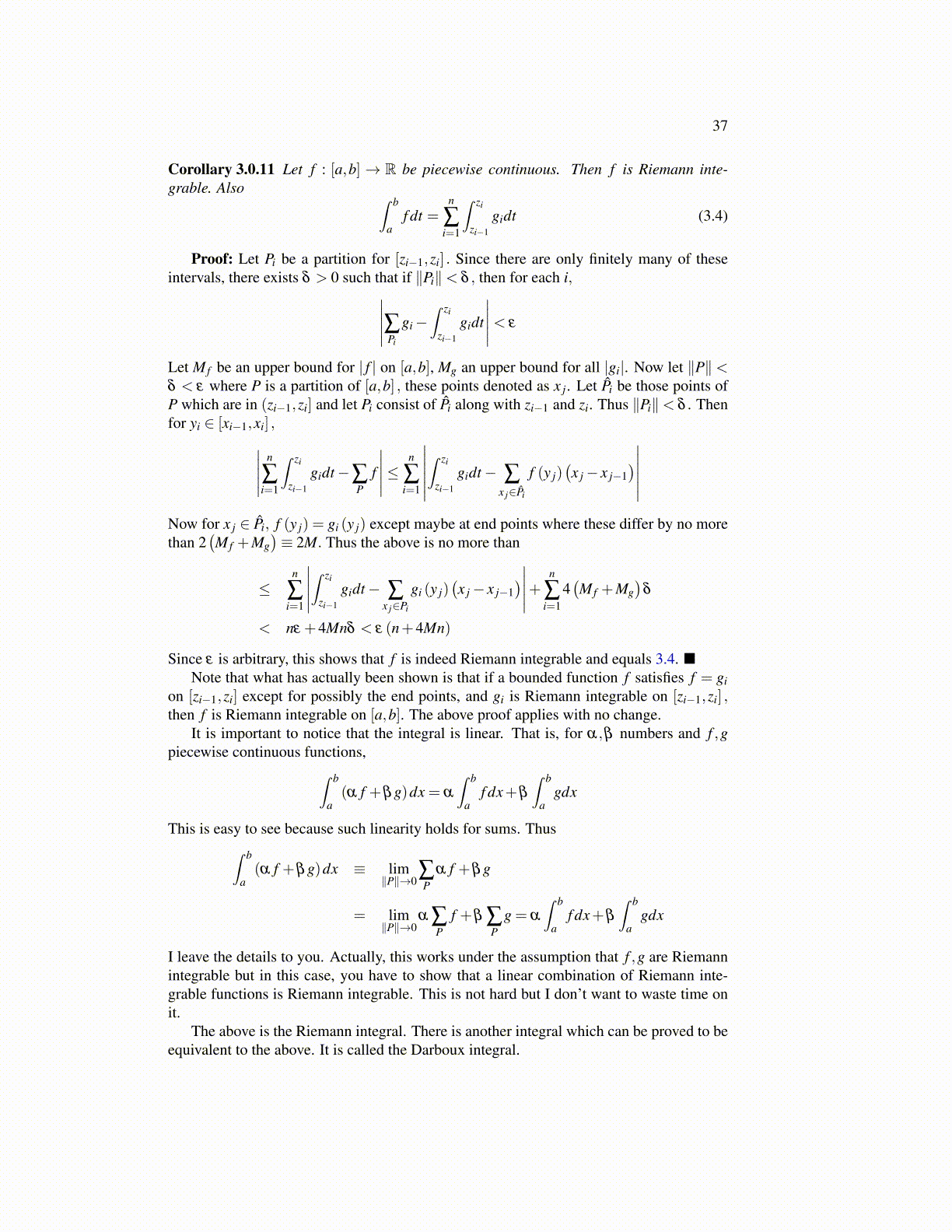
37
Corollary 3.0.11 Let f : [a,b]→ R be piecewise continuous. Then f is Riemann inte-grable. Also ∫ b
af dt =
n
∑i=1
∫ zi
zi−1
gidt (3.4)
Proof: Let Pi be a partition for [zi−1,zi] . Since there are only finitely many of theseintervals, there exists δ > 0 such that if ∥Pi∥< δ , then for each i,∣∣∣∣∣∑Pi
gi−∫ zi
zi−1
gidt
∣∣∣∣∣< ε
Let M f be an upper bound for | f | on [a,b], Mg an upper bound for all |gi|. Now let ∥P∥<δ < ε where P is a partition of [a,b] , these points denoted as x j. Let P̂i be those points ofP which are in (zi−1,zi] and let Pi consist of P̂i along with zi−1 and zi. Thus ∥Pi∥< δ . Thenfor yi ∈ [xi−1,xi] ,∣∣∣∣∣ n
∑i=1
∫ zi
zi−1
gidt−∑P
f
∣∣∣∣∣≤ n
∑i=1
∣∣∣∣∣∣∫ zi
zi−1
gidt− ∑x j∈P̂i
f (y j)(x j− x j−1
)∣∣∣∣∣∣Now for x j ∈ P̂i, f (y j) = gi (y j) except maybe at end points where these differ by no morethan 2
(M f +Mg
)≡ 2M. Thus the above is no more than
≤n
∑i=1
∣∣∣∣∣∫ zi
zi−1
gidt− ∑x j∈Pi
gi (y j)(x j− x j−1
)∣∣∣∣∣+ n
∑i=1
4(M f +Mg
)δ
< nε +4Mnδ < ε (n+4Mn)
Since ε is arbitrary, this shows that f is indeed Riemann integrable and equals 3.4. ■Note that what has actually been shown is that if a bounded function f satisfies f = gi
on [zi−1,zi] except for possibly the end points, and gi is Riemann integrable on [zi−1,zi] ,then f is Riemann integrable on [a,b]. The above proof applies with no change.
It is important to notice that the integral is linear. That is, for α,β numbers and f ,gpiecewise continuous functions,∫ b
a(α f +βg)dx = α
∫ b
af dx+β
∫ b
agdx
This is easy to see because such linearity holds for sums. Thus∫ b
a(α f +βg)dx ≡ lim
∥P∥→0∑P
α f +βg
= lim∥P∥→0
α ∑P
f +β ∑P
g = α
∫ b
af dx+β
∫ b
agdx
I leave the details to you. Actually, this works under the assumption that f ,g are Riemannintegrable but in this case, you have to show that a linear combination of Riemann inte-grable functions is Riemann integrable. This is not hard but I don’t want to waste time onit.
The above is the Riemann integral. There is another integral which can be proved to beequivalent to the above. It is called the Darboux integral.